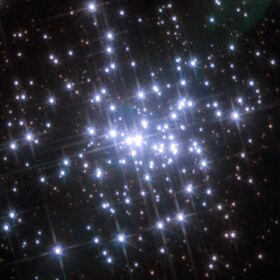Astronomy:NGC 3603-C
 C is the brightest star to the left of the very close A (three not quite resolved stars at the very centre of the image) and B pair at the centre in this HST image of the central region of HD 97950. Credit: NASA, ESA and Wolfgang Brandner (MPIA), Boyke Rochau (MPIA) and Andrea Stolte (University of Cologne) | |
| Observation data Epoch J2000.0 Equinox (celestial coordinates) | |
|---|---|
| Constellation | Carina |
| Right ascension | 11h 15m 07.589s[1] |
| Declination | −61° 15′ 38.00″[1] |
| Apparent magnitude (V) | 11.89[1] |
| Characteristics | |
| Spectral type | WN6h+?[2] |
| B−V color index | 1.05[1] |
| Astrometry | |
| Proper motion (μ) | RA: 2.4[3] mas/yr Dec.: 2.8[3] mas/yr |
| Distance | 7,600[2] pc |
| Absolute magnitude (MV) | −7.17[2] |
| Orbit[4] | |
| Primary | C |
| Period (P) | 8.89 ± 0.01 days |
| Eccentricity (e) | 0.30 ± 0.04 |
| Inclination (i) | 71° |
| Periastron epoch (T) | 2453546.61 ± 0.18 |
| Argument of periastron (ω) (secondary) | 281 ± 7° |
| Semi-amplitude (K1) (primary) | 200 ± 23 km/s |
| Details | |
| Mass | 113[2] M☉ |
| Radius | 26.2[2] R☉ |
| Luminosity | 2,200,000[2] L☉ |
| Temperature | 44,000[2] K |
| Age | 1.5[2] Myr |
| Other designations | |
NGC 3603-C, CD-60°3452C, CPD-60°2732C, HD 97950C, HIP 54948C, WR 43c, AAVSO 1110-60, NGC 3603 MDS 18 | |
| Database references | |
| SIMBAD | data |
NGC 3603-C (HD 97950C) is a single-lined spectroscopic binary star system located at the centre of the HD 97950 cluster in the NGC 3603 star-forming region, about 25,000 light years from Earth. The primary has spectral type WN6h and is among the most luminous and most massive known.
HD 97950 was catalogued as a star, but was known to be a dense cluster or close multiple star. In 1926, the six brightest members were given letters from A to F,[5] although several of them have since been resolved into more than one star.[6] Star C was shown to be a binary, but its companion has not been observed.[4]
HD 97950C is a Wolf-Rayet (WR) star, with spectra dominated by strong broadened emission lines. Type WN6 indicates that ionised nitrogen lines are strong in comparison to ionised carbon lines, and the suffix h indicates that hydrogen is also seen in the spectrum. This type of WR star is not the classical stripped helium-burning aged star, but a young highly luminous object with CNO cycle fusion products showing at the surface due to strong conventional and rotational mixing, and high mass loss rates from the atmosphere. The emission lines are generated in the stellar wind and the photosphere is completely hidden. The surface fraction of hydrogen is still estimated to be 70%.[2]
The two component stars of NGC 3603-C circle each other every nine days. It is assumed that the secondary is sufficiently smaller and fainter than the primary not to affect the calculation of its physical properties. The mass is estimated to be 113 M☉ and the luminosity over two million L☉. Although the star is very young, around 1.5 million years old, it has already lost a considerable fraction of its initial mass. The initial mass is estimated to have been 137 M☉, meaning it has lost 24 M☉.[2]
See also
References
- ↑ 1.0 1.1 1.2 1.3 Melena, Nicholas W.; Massey, Philip; Morrell, Nidia I.; Zangari, Amanda M. (2008). "The Massive Star Content of NGC 3603". The Astronomical Journal 135 (3): 878–891. doi:10.1088/0004-6256/135/3/878. ISSN 0004-6256. Bibcode: 2008AJ....135..878M.
- ↑ 2.00 2.01 2.02 2.03 2.04 2.05 2.06 2.07 2.08 2.09 Crowther, P. A.; Schnurr, O.; Hirschi, R.; Yusof, N.; Parker, R. J.; Goodwin, S. P.; Kassim, H. A. (2010). "The R136 star cluster hosts several stars whose individual masses greatly exceed the accepted 150 M⊙ stellar mass limit". Monthly Notices of the Royal Astronomical Society 408 (2): 731–751. doi:10.1111/j.1365-2966.2010.17167.x. Bibcode: 2010MNRAS.408..731C.
- ↑ 3.0 3.1 Zacharias, N. et al. (2003). "The Second U.S. Naval Observatory CCD Astrograph Catalog (UCAC2)". CDS/ADC Collection of Electronic Catalogues 1289. Bibcode: 2003yCat.1289....0Z.
- ↑ 4.0 4.1 Schnurr, O.; Casoli, J.; Chené, A. -N.; Moffat, A. F. J.; St-Louis, N. (2008). "The very massive binary NGC 3603-A1". Monthly Notices of the Royal Astronomical Society: Letters 389 (1): L38–L42. doi:10.1111/j.1745-3933.2008.00517.x. Bibcode: 2008MNRAS.389L..38S.
- ↑ Van Den Bos, W. H. (1928). "Another nebulous multiple star". Bulletin of the Astronomical Institutes of the Netherlands 4: 261. Bibcode: 1928BAN.....4..261V.
- ↑ Moffat, Anthony F. J.; Drissen, Laurent; Shara, Michael M. (1994). "NGC 3603 and its Wolf-Rayet stars: Galactic clone of R136 at the core of 30 Doradus, but without the massive surrounding cluster halo". Astrophysical Journal 436: 183. doi:10.1086/174891. Bibcode: 1994ApJ...436..183M.
External links
- NASA Astronomy Picture of the Day: Starburst Cluster in NGC 3603 (5 October 2007)
- NASA Image of the day
 |
